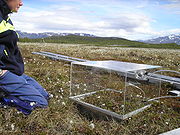
Abisko Scientific Research Station
Encyclopedia
The Abisko Scientific Research Station (ANS) is a field research station
belonging to the Royal Swedish Academy of Sciences
. Situated on the south shore of Lake Torneträsk
, it lies at the edge of the Abisko National Park
and is used by researchers from many countries. The varied geological, topographical and climatic conditions of the area allow it to be inhabited by a range of flora
and fauna
. These features which have caused the area to be given National Park
status also make it an important place for scientific research, particularly of alpine and subalpine
ecosystems.
The research station today consists of laboratories and general workrooms containing a variety of scientific equipment, and also of various 'outposts' where research is carried out in situ. It is used for research, teaching and meetings, and has a large collection of scientific books and papers available on site.
 Though many research projects are carried out at the station regarding geography
Though many research projects are carried out at the station regarding geography
and biology
in general, particular emphasis is placed on meteorology
and plant ecology
. Many of these projects overlap as the station hosts research into climate change
in the region and the resulting changes to plant communities.
Research station
A research station is a station built for the purpose of conducting scientific research. Research station sites might include outer space and oceans. Many nations have research stations in Antarctica; Showa Station, Halley and Troll are examples...
belonging to the Royal Swedish Academy of Sciences
Royal Swedish Academy of Sciences
The Royal Swedish Academy of Sciences or Kungliga Vetenskapsakademien is one of the Royal Academies of Sweden. The Academy is an independent, non-governmental scientific organization which acts to promote the sciences, primarily the natural sciences and mathematics.The Academy was founded on 2...
. Situated on the south shore of Lake Torneträsk
Torneträsk
Torneträsk or Torne träsk is a lake in Kiruna Municipality, Lapland, Norrbotten County in Sweden, in the Scandinavian mountain range. Träsk is the local word for lake . It is the seventh largest lake in Sweden, with a total area of and a length of...
, it lies at the edge of the Abisko National Park
Abisko National Park
Abisko National Park is a National Park in Sweden.Geographically, Abisko is situated in the Swedish province of Lapland near the Norwegian border , and belongs to Kiruna Municipality, Sweden's northernmost and largest municipality...
and is used by researchers from many countries. The varied geological, topographical and climatic conditions of the area allow it to be inhabited by a range of flora
Flora
Flora is the plant life occurring in a particular region or time, generally the naturally occurring or indigenous—native plant life. The corresponding term for animals is fauna.-Etymology:...
and fauna
Fauna
Fauna or faunæ is all of the animal life of any particular region or time. The corresponding term for plants is flora.Zoologists and paleontologists use fauna to refer to a typical collection of animals found in a specific time or place, e.g. the "Sonoran Desert fauna" or the "Burgess shale fauna"...
. These features which have caused the area to be given National Park
National park
A national park is a reserve of natural, semi-natural, or developed land that a sovereign state declares or owns. Although individual nations designate their own national parks differently A national park is a reserve of natural, semi-natural, or developed land that a sovereign state declares or...
status also make it an important place for scientific research, particularly of alpine and subalpine
Subalpine
The subalpine zone is the biotic zone immediately below tree line around the world. Species that occur in this zone depend on the location of the zone on the Earth, for example, Snow Gum in Australia, or Subalpine Larch, Mountain Hemlock and Subalpine Fir in western North America.Trees in the...
ecosystems.
The Station
The first proper field station to be established in the area dates back to 1903, however the official station has only been affiliated with the Royal Swedish Academy of Sciences since 1935.The research station today consists of laboratories and general workrooms containing a variety of scientific equipment, and also of various 'outposts' where research is carried out in situ. It is used for research, teaching and meetings, and has a large collection of scientific books and papers available on site.
Current Research

Geography
Geography is the science that studies the lands, features, inhabitants, and phenomena of Earth. A literal translation would be "to describe or write about the Earth". The first person to use the word "geography" was Eratosthenes...
and biology
Biology
Biology is a natural science concerned with the study of life and living organisms, including their structure, function, growth, origin, evolution, distribution, and taxonomy. Biology is a vast subject containing many subdivisions, topics, and disciplines...
in general, particular emphasis is placed on meteorology
Meteorology
Meteorology is the interdisciplinary scientific study of the atmosphere. Studies in the field stretch back millennia, though significant progress in meteorology did not occur until the 18th century. The 19th century saw breakthroughs occur after observing networks developed across several countries...
and plant ecology
Plant ecology
Plant ecology is a subdiscipline of ecology which studies the distribution and abundance of plants, the interactions among and between members of plant species, and their interactions with their environment...
. Many of these projects overlap as the station hosts research into climate change
Climate change
Climate change is a significant and lasting change in the statistical distribution of weather patterns over periods ranging from decades to millions of years. It may be a change in average weather conditions or the distribution of events around that average...
in the region and the resulting changes to plant communities.

